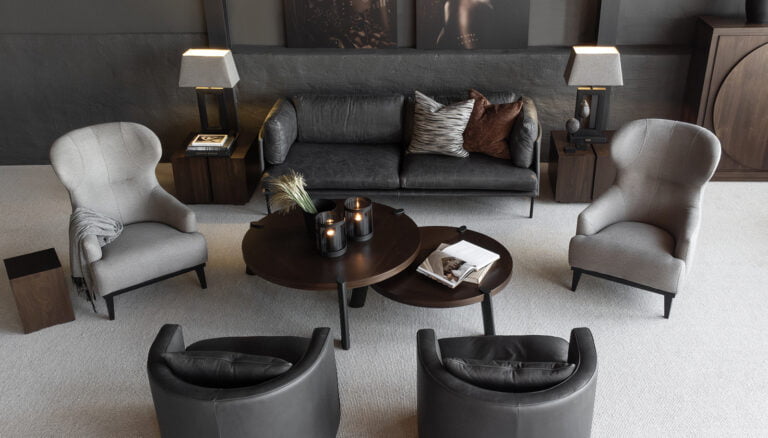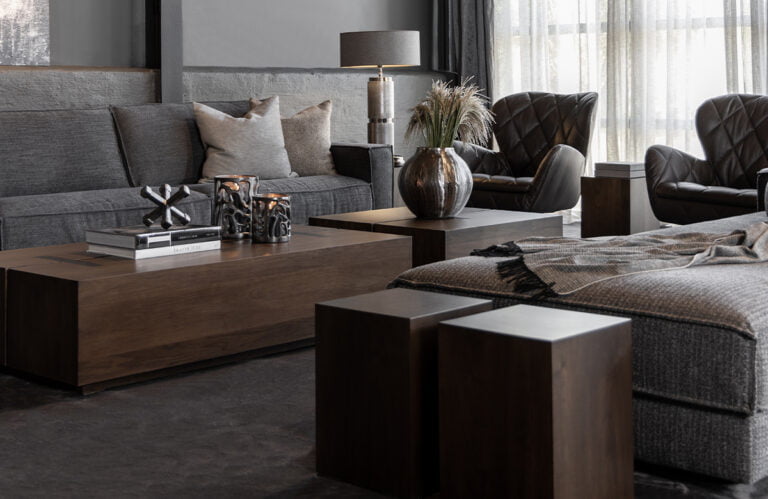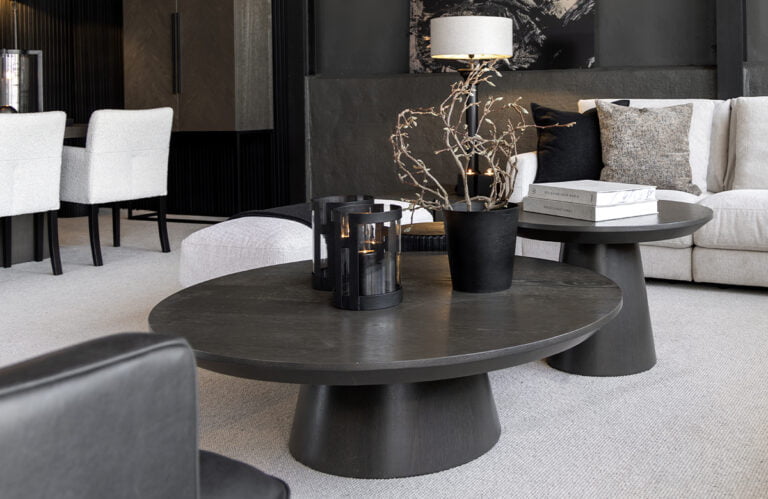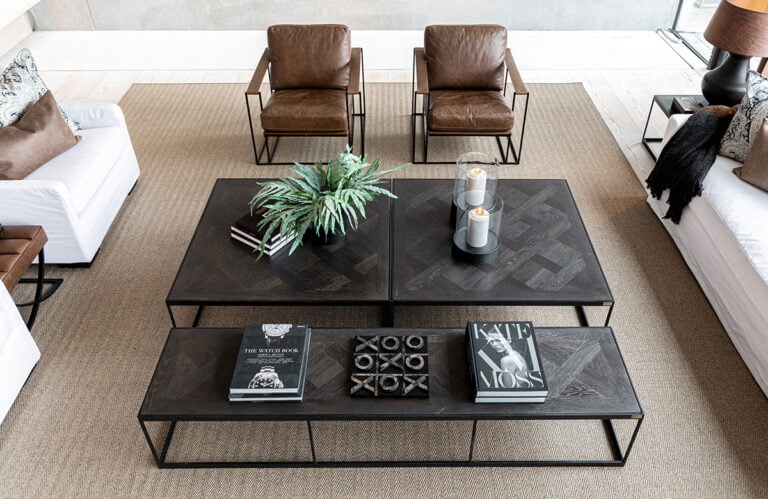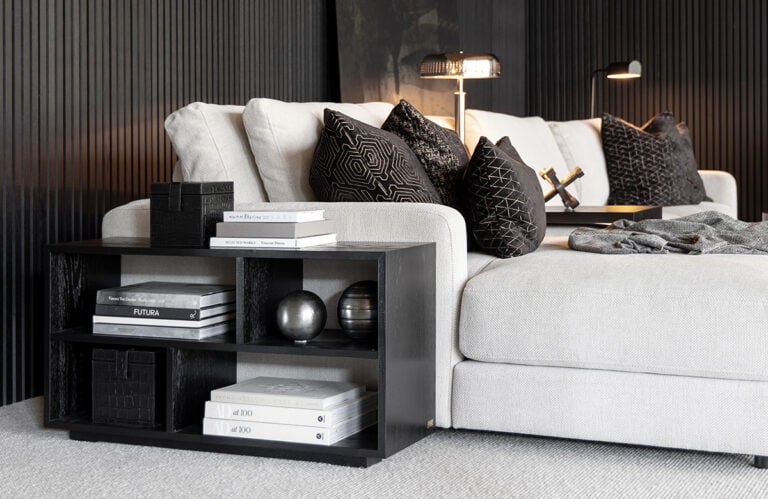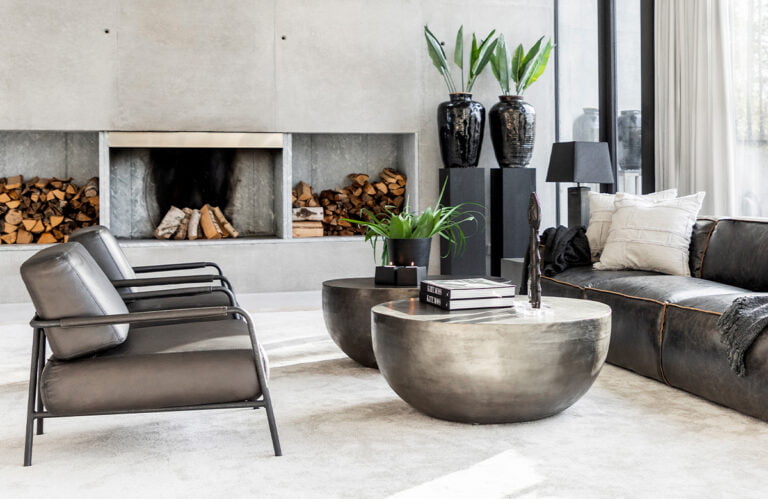1. SIZE
When choosing the size of your coffee table, consider the proportions of both the room and the sofa. Before finalizing your decision, lay out the table’s dimensions on the floor at home. Ensure the coffee table doesn’t occupy all the space in front of the sofa. Maintaining some distance between the sofa and the table creates an airy feel and facilitates easier movement. The table’s length should be half, or at most two-thirds the width of the sofa. While many coffee tables stand at approximately 45 cm in height, it’s best to choose a table that aligns with or sits slightly below the height of your sofa’s seat.
2. SHAPE
The shape of your coffee table affects both its aesthetic appearance and its function in the room. When deciding on a shape, consider the configuration of your seating area and the desired flow of the space.
Round: Round coffee tables create a soft and inviting impression, and you avoid sharp corners. If your room is dominated by straight lines and angles, a round table can help balance the decor.
Rectangular: Rectangular tables fits for larger rooms and offer lots of space on top. If you have two sofas opposite each other or a sectional sofa, a rectangular coffee table might be a good choice.
Nesting: It can be both stylish and practical to use several smaller set tables so that they together form a coffee table. The advantage of set tables is that you can easily move one or more of the tables if you want to rearrange the furniture.
3. MATERIALS
When selecting a coffee table, the material plays a significant role in both style and functionality.
Wooden tables: Wood brings a natural warmth and character to the room. Its unique grain and array of colors offer styles ranging from rustic to elegant. Depending on the finish, matte, lacquere or weathered, wood tables can complement most interior designs. Wood is also a durable material, but may need some maintenance over time to deal with any stains or wear.
Veneer: A table in veneer offers a modern touch, and is both functional and cost-effective. They’re a great choice for those wanting the appearance and feel of wood without the higher cost of solid wood. With proper care, a veneer table can last for many years and become a loved feature in your home.
Glass tables: Perfect for compact areas or open floor plans. The transparency of a glass table adds a sense of space and openness. However, they tend to show fingerprints and dirt, so regular cleaning might be needed. Consider tempered glass for added strength and safety.
Metal tables: The versatility of metal is reflected in its various finishes. A table in polished chrome or stainless steel emphasizes a modern style, while iron or aged metal evokes a sense of vintage or industrial. Metal is often used as a frame or base in combination with a table top in other materials. They are durable and easy to maintain, but some metals might need special care to prevent rust or discoloration.
Stone or marble tables: Each table has its own patterns from nature, making it unique. They feel sturdy and their cool surface adds a touch of luxury to a room. These tables last a long time and always look elegant, regardless of the decor. A great choice for those who want something that stands out! Their porous surface can be sensitive to stains from spills or oils. To maintain their shine, regular care and gentle cleaning are required.
4. FUNCTION AND STORAGE
A functional coffee table can completely transform the ambiance of the living room. By combining stylish design with clever storage, the room becomes both elegant and organized. The table’s shelves provide space for books and decorations, while built-in drawers offer discreet storage for the room’s miscellaneous items.
5. STYLE
Your coffee table should complement your room. Is your decor more on the classic side, or does it lean more towards the modern? Choose a table that enhances the room’s overall ambiance.
Traditional: Coffee tables with timeless design, often featuring intricate carvings and solid woods such as mahogany or oak. The classic design is especially suitable for more traditionally decorated homes, adding a touch of bygone elegance.
Modern: Characterized by simple, clean lines and minimalist design. Modern coffee tables are often made from combined materials such as glass and metal. They fit perfectly in contemporary and scandinavian homes.
Rustic: Focusing on the rustic and close-to-nature elements. These tables are often made of raw or reclaimed wood. Natural imperfections and irregularities become part of the design, creating a cozy and earthy feel.
Industrial: Coffee tables with an industrial vibe are often characterized by their raw and unpolished appearance. They can be made from materials such as raw steel, cast iron, reclaimed wood, and concrete. The structure of these tables is typically simple, sturdy, and without unnecessary embellishments.
 English
English Svenska
Svenska

